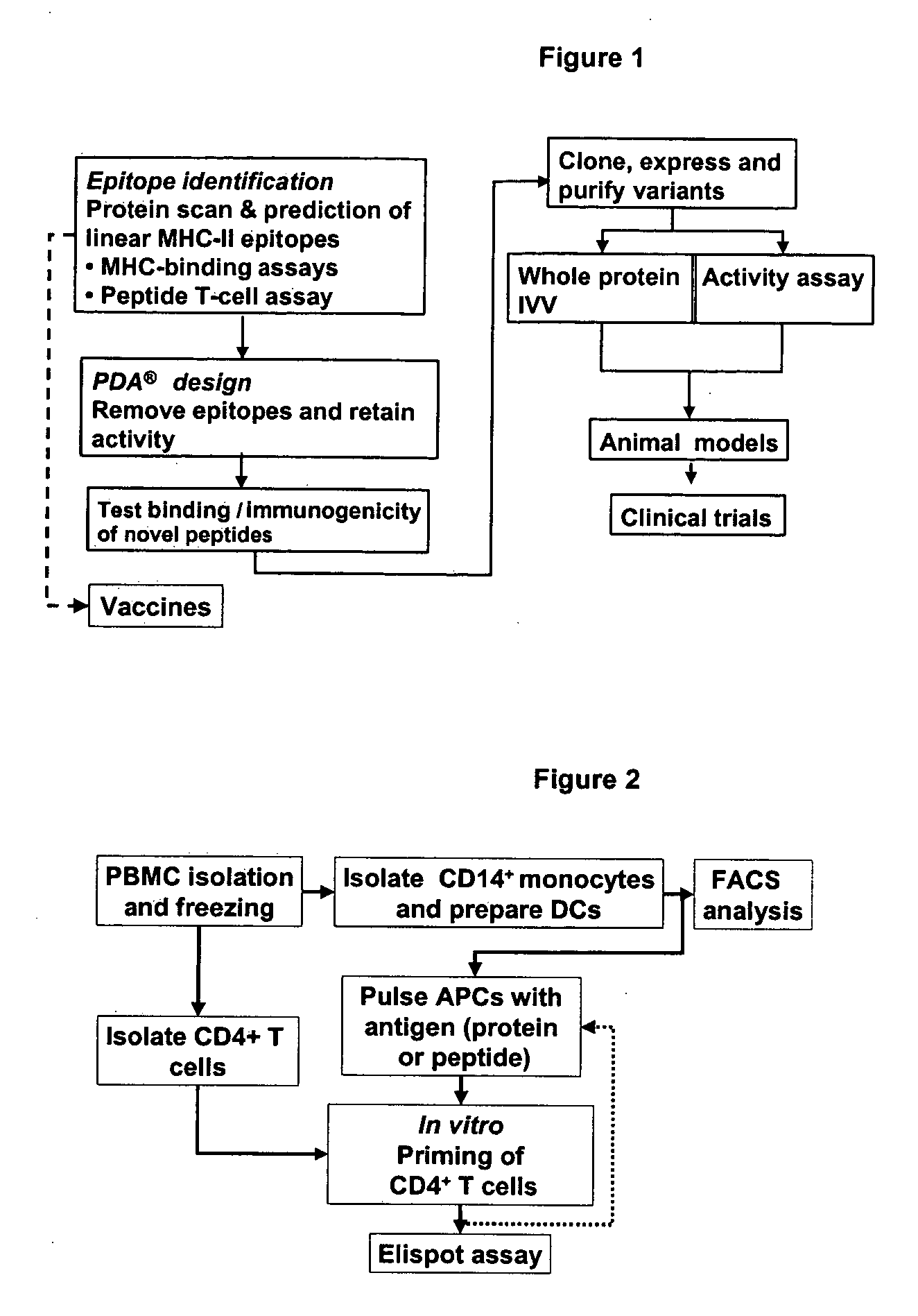C1q family member proteins with altered immunogenicity
a member protein and immunogenicity technology, applied in the field of c1q super family member proteins with reduced immunogenicity, can solve the problems of limiting the efficacy and safety of a protein therapeutic in multiple ways, affecting and affecting the effect of immunogenicity, so as to maintain the activity of native naturally occurring proteins and reduce binding affinity
- Summary
- Abstract
- Description
- Claims
- Application Information
AI Technical Summary
Benefits of technology
Problems solved by technology
Method used
Image
Examples
example 1
Identification of MHC-Binding Agretopes in C1q SF Members
[0108] Matrix method calculations (Sturniolo, supra) were conducted using the parent C1q SF members sequences: Adiponectin (SEQ_ID_NO:1) and CTRP1 (SEQ_ID_NO:2).
[0109] Agretopes were predicted for the following alleles, each of which is present in at least 1% of the US population: DRB1*0101, DRB1*0102, DRB1*0301, DRB1*0401, DRB1*0402, DRB1*0404, DRB1*0405, DRB1*0408, DRB1*0701, DRB1*0801, DRB1*1101, DRB1*1102, DRB1*1104, DRB1*1301, DRB1*1302, DRB1*1501, and DRB1*1502.
[0110] Table 2. Predicted MHC-binding agretopes in C1q SF members. Iscore, the number of alleles, and the percent of the population hit at 1%, 3%, and 5% thresholds are shown. Especially preferred agretopes are predicted to affect at least 10% of the population, using a 1% threshold.
Agretope1%3%5%1%3%5%numberResiduesSequenceIscorehitshitshitspoppoppopTable 2.A. Predicted MHC-binding agretopes in Adiponectin.Ag. A1109-117YVYRSAFSV36.925711%44%57%Ag. A2111-119Y...
example 2
Identification of Suitable Less Immunogenic Sequences for MHC-Binding Agretopes in C1q SF Members
[0112] MHC-binding agretopes that were predicted to bind alleles present in at least 10% of the US population, using a 1% threshold, were analyzed to identify suitable less immunogenic variants. At each agretope, all possible combinations of amino acid substitutions were considered, with the following requirements: (1) each substitution has a score of 0 or greater in the BLOSUM62 substitution matrix, (2) each substitution is capable of conferring reduced binding to at least one of the MHC alleles considered, and (3) once sufficient substitutions are entirely incorporated to prevent any allele hits at a 1% threshold, no additional substitutions are added to that sequence.
[0113] Alternate sequences were scored for immunogenicity and structural compatibility. Preferred alternate sequences were defined to be those sequences that are not predicted to bind to any of the 17 MHC alleles tested...
example 3
Identification of Suitable Less Immunogenic Sequences for MHC-Binding Agretopes as Determined by PDA® Technology
[0115] Table 5. Each position in the agretopes of interest was analyzed to identify a subset of amino acid substitutions that are potentially compatible with maintaining the structure and function of the protein. PDA® technology calculations were run for each position of each 9-mer agretope and compatible amino acids for each position were saved. In these calculations, side-chains within 5 Angstroms of the position of interest were permitted to change conformation but not amino acid identity. The variant agretopes were then analyzed for immunogenicity. The PDA® energies and Iscore values for the wild-type 9-mer agretope were compared to the variants and the subset of variant sequences with lower predicted immunogenicity and PDA® energies within 5.0 kcal / mol of the wild-type were noted. In the tables below, E(PDA) is the energy determined using PDA® technology calculations...
PUM
| Property | Measurement | Unit |
|---|---|---|
| Immunogenicity | aaaaa | aaaaa |
Abstract
Description
Claims
Application Information
 Login to View More
Login to View More - R&D
- Intellectual Property
- Life Sciences
- Materials
- Tech Scout
- Unparalleled Data Quality
- Higher Quality Content
- 60% Fewer Hallucinations
Browse by: Latest US Patents, China's latest patents, Technical Efficacy Thesaurus, Application Domain, Technology Topic, Popular Technical Reports.
© 2025 PatSnap. All rights reserved.Legal|Privacy policy|Modern Slavery Act Transparency Statement|Sitemap|About US| Contact US: help@patsnap.com

